#i had to convert an array of numbers
Explore tagged Tumblr posts
Text
Coding is funny as fuck (while ur not doing it.) i was trying to get something to work and it had been like an hour+ before i tried something else, longhand. (But simple way, so I still kiiinda saved some time?)
Ed was in the room w me and hearing me bitch and cuss and plead to the fucking computer, occasionally injecting jokes in my miserable fit.
I figured out what it was, faced ed, sneered and put my head in my hands. Told them, “I figured out the answer.”
Ed waited for me to continue, because what the fuck does that mean when u dont code.
Then, I said: “I don’t like the answer.”
#i had to convert an array of numbers#pulled fucking ASYNC STYLE#into an array of strings. dynamically.#the array had a length of 702.#and its length will increase in the future.#working async w an array of objects#and doing shit w the array#w/o losing sync along the way#is pretty new shit to me.#thankfully i knew i just had to map the thing somehow.#javascript#jquery
3 notes
·
View notes
Text
(I Will Soon Be Offering) Private Guitar Lessons

A few months ago one of my followers asked if I had ever thought about offering guitar lessons online via webcam. I replied that it was indeed something I had thought about but that I would need to give it more thought as to how I would approach teaching online, whether or not I had the proper equipment to provide a professional experience, how many students I could take on, and what exactly I could offer as a teacher. I also noted that I would have to create a suitable space in my apartment for hosting students. This last part took care of itself when my roommate moved out and I am presently converting his old bedroom into an office. As for the rest? Well I gave it some thought and I've hacked together reasonable solutions for most of those other issues, so I would like to announce that beginning later this winter/this spring I will be offering private one-on-one guitar lessons via webcam.
My Qualifications:
While I graduated with a degree in Classics and attended graduate school in that field, I was initially accepted into university as a music major on the basis of my guitar playing. It was only after a few years that I switched majors into Classics. In the end I still managed enough credits to claim a minor in music.
Before attending university I spent a year studying jazz theory/jazz improvisation at the college level.
Both prior to and concurrent with my college/university music education I studied classical guitar privately with a teacher for a little over a decade; through him I can claim teaching lineage back to Francisco Tárrega.
I have played in a few garage bands that never really went anywhere, performed with friends at house parties, jammed around as much as I could, and performed live as a solo guitarist.
I previously taught guitar while in university; this is not my first rodeo.
I have been playing guitar for a little over twenty three years.
What I Can Offer:
If you're a beginner I can happily guide your playing to a level where you would feel comfortable learning songs on your own, and we would start with learning basic chords, basic technique, and putting it all together into learning a few songs.
If you're past the beginner stage, I can take your playing to a level where you would be able to convincingly improvise a solo over a song, play more advanced songs, and sit in with a jam session.
If learning to read sheet music is a goal am able to assist with that.
If you're interested in beginner classical guitar I would feel comfortable teaching repertoire and technique to the level of Royal Conservatory of Music Grade Five examinations. Grade Five repertoire is typically the minimum requirement when auditioning on guitar for a university level music program in Canada. I have several guitar methods at my disposal for teaching technique, and access to a wide array of repertoire sheet music.
I am also able to teach theory as it pertains to playing the guitar and point you towards texts that from beginner levels up to basic harmonic analysis. I can teach you how chords are constructed, how they fit together into a progression, and the basic grammar of music.
Lessons, Pricing, What to Expect, What a Prospective Student Will Require:
The going rate for private music lessons is $40-$50 per hour and ranges up to well over $100 for some in demand teachers. My fee operates on a sliding scale with a floor of $20USD/$25CAD per hour. If you are comfortable paying the typical going rate, wonderful, if you are unable to afford that, we can work something out, no questions asked. Payment should be sent through PayPal or Interac e-transfer.
Due to chronic illness I can't take on more than five students a week. They needn't necessarily be the same five students every week; if a bi-weekly lesson schedule works better for a number of people, they can alternate. In the rare event that there is more demand than that mutuals and longtime followers will have priority.
What you need as a student: A guitar; a webcam; a microphone; a way of letting me hear your playing. This could mean having your microphone positioned so that I can hear your amplifier clearly, or by using a direct input. Feel free to shoot me a message if you want some recommendations for inexpensive DI-boxes and audio interfaces. Headphones would be a good idea too.
If you commit to more than one lesson the first will be free of charge. Your first lesson with me will look something like this: we'll talk about your goals and intentions i.e. what it is you hope to get out of taking guitar lessons and how far you want to take your playing. As we chat about that we can chart out a course to get you there, and then we'll just generally see where you're at. The rest of the lesson will be taken up with some pointers on properly caring for and tuning your instrument, and then we'll put some thought towards the way our bodies are posed, how we have the guitar positioned in relation to our bodies, exercising good hand ergonomics, and finding a playing position that is both comfortable and which allows for optimal freedom of movement.
I live in Toronto which is UTC -5 keep this in mind if you're interested in taking lessons and are located elsewhere.
I intend to do my best at being a trooper and toughing it out, and I will aim to not cancel lessons without fair warning, but the nature of my illness means that I may need to resort to this occasionally. You will need to be alright with this.
If you're interested, you can contact me here or at [email protected]. Hopefully I can get enough people interested that I can go about figuring out everyone's availability and drawing up a schedule.
100 notes
·
View notes
Text

Part 7: The Tower
a story by @rox-and-prose and @cipheramnesia
Dusk turned the Nevamil sky a flat aquamarine, and made visible the red lights blinking atop the Citadel. It was the tallest building in the capital city, Aureodar, even visible from the far off gridded streets of old houses converted into apartments. The last time Laika had seen it was a field trip for school.
The little blue Kirov was somewhere between the mountains and Genghis Khan and the most anonymous hopper port they'd been able to find in Aureodar. She worried about Sy, seemed ages past she'd been this physically far, though it was hardly more than weeks. Wires and talismans crossed over the streets, bikes and busses swooshed wet pavement, and linecars screeched overhead, all wrapped around her and her backpack and familiar unknown faces of the United Eastquad Block.
Ghosts gathered around her, whispering. You keep coming back here little wolf girl, you'll never get away from this place. Little wolf girl, you know you belong here. Freak. Queer. Sissy. Killer. Monster. You thought you were better than us, you never were. Laika let them needle and claw her. They were her ghosts, not the other way round. Every horrible word only built her up. Luna was with her in that way.
Most of the houses on K Street were mods, from early to late first century post-terraform. They were all retrofited from the original single family modules, but they were tough as nails, old construction built to weather thr storms of atmosphere generation. Number 1132 was where she was headed, lights were still on in the third floor windows.
Laika took a last look around on the front door's stoop. The poles for street lights and warden ropes all had at least three CCTV cameras and arrayed parabolic empathy receivers tuned into psychic conflict between morality and legality. She flashed a tight little smile at the familiar old glass eye of the state before pulling a short crowbar out of her bag and cracking the door open.
The third floor smelled of some sharp, fragrant allium along with sweet woody flavors and cooking meat, enough to rouse her stomach. Deep breath, ignore the ghosts, knock. A woman with her black hair in a bob cut, rolled up sleeves on her billowy dress, a little sweaty and confused, almost a quarter meter shorter than Laika. A wave of gaming sounds, net music, and oven warmth joined them both on the landing.
"Hey Tara," Laika said.
The other woman looked closer. "Laika? Oh tides, it is!" She wrapped Laika up in a big soft hug inside thick arms, crushing her stick body. "I thought you, I don't know, I thought you were dead! I mean, there were rumors?"
"Uff! Uh, hey. Sorry to be like, unannounced. Is it okay if I come in?" Laika hesitantly patted Tara's shoulders until the hug relaxed and her feet were back on the floor.
"You just have to, please. I'm sorry, when did you get back, why didn't you call?"
Unlacing her boots and slipping them off, she said, "I just got back today, um. I've been a bit off the net you know." She dipped her hand in the tiny basin by the door and thumbed a drop of water on the polished river stone at the altar. "But I wanted to see how you'd been, I guess. It just, well it's weird. That smells amazing."
She saw a couple kids blasting through uncreatively humanoid aliens, loudly and luridly across the living room screen, followed Tara into the kitchen and dinette area and watched her stir around sizzling veggies and meat in a wide dish. "Thanks," Tara said. "The spawn over there don't always appreciate it, but you know how... well, how kids can be..." Tara frowned awkwardly.
"Yeah, uh. Yeah." Laika rubbed the back of her neck. "So what all have you heard?"
Tara stuttered with a little embarassment. In the distance Laika could very faintly hear sirens, but she knew they weren't for her. The people who would come for her didn't use sirens or advertise their presence.
Half paying attention to Tara, she added, "Well, uh, some is true. But... you knew it was bad at home. Stuff happened. What about you though? Like, two kids? Wow!"
Tara probably was relieved at the change of topic, and Laika was glad to take a minute, but she couldn't focus all the way. She was waiting.
101 notes
·
View notes
Note
is it possible for people to like, create old consoles/computers from scratch? like if they could replicate the physical hardware using new materials, and plant old software onto the new hardware to create like, a totally new, say, win98 pc? cause i browse online and see a lot of secondhand stuff, but the issue is always that machines break down over time due to physical wear on the hardware itself, so old pcs aren't going to last forever. it makes me wonder if at a certain point, old consoles and computers are just gonna degrade past usability, or if it's possible to build new pieces of retro hardware just as they would have been built 30 or 40 years ago
Can of worms! I am happy to open it though. For the moment I will ignore any rights issues for various reasons including "those eventually expire" and "patent law is the branch of IP law I know the least about"
Off the top of my head so long as you're only* talking computer/console hardware there aren't any particular parts that we've lost the capability to start manufacturing again, but there's more economical approaches to building neo-retro** hardware.
But before digging into that I would like to mention that anecdotally, a great many hardware failures I see on old computers are on parts that you can just remove and replace with something new. Hard drive failures, floppy disc drive failures, damaged capacitors, various issues with batteries/battery compartments, these are mostly fixable without resorting to scavenging genuine old parts. Hard drive and floppy drive failures may require finding something that you can actually plug into the device but this isn't strictly impossible.
Additionally, it's common among retro computing enthusiasts to replace some of these parts with fancier parts than were possible when those machines were new. The primary use cases for buying say, floppy-to-USB converters are keeping old industrial and aviation computers alive longer, but hobbyists do also buy these (I want to put one in my 9801 too but that's pricy so it's just on my wishlist for after I have finished school and settled down ;u;) Sticking SSDs in old computers is also not an uncommon mod.
So-- hold on let me grab my half-disassembled PC-9801 BX2 to help me explain


(Feat. the parts I pulled out of it in the second photo)
In that second photo we have some ram modules, a power supply, floppy drives, a hard drive, and floppy+hard drive cables. The fdd+hdd+cables are easily replaceable with new parts as mentioned, the power supply is a power supply, and the ram chips are... actually I don't know a lot about this one. I have enough old ram chips laying around that I haven't had to think hard about how to replace them.
Now in photo number 1 we have the motherboard and some expansion chips. The sound card is centered a bit here*** and underneath it is a video expansion card and underneath that interesting expansion card setup is the motherboard itself.
The big kickers for manufacturing new would be the CPU and the sound card-- you in theory could make those new but chip fabrication is only economical if it's done beyond a certain scale that's not quite realistic for a niche hobbyist market.
But what you could use instead of those is an FPGA, or Field Programmable Gate Array. These aren't within my field of expertise so to simplify a bit, these are integrated chips (like a CPU or a sound chip) but unlike those, they can be reprogrammed after manufacture, rather than having a set-in-stone layout. So you could program one to act as an old CPU, at a cost that is... more than that of getting a standard mass-manufactured CPU, and less than attempting small scale manufacture of a CPU.
So in theory you could plunk one of those down into a custom circuit board, use the closest approximate off the shelf parts, and make something that runs like a pc-98 (or commodore, or famicom, or saturn, or whatever.) In practice as far as I'm aware, users who want hardware like this use something like the MiSTer FPGA (Third party link but I think it's a pretty useful intro to the project)
And of course for many users, emulation will also do the trick.
*manufacturing cathode ray tube displays is out of the question
**idk if this is a term but I hope it is. If it's not, I'm coining it
***That's a 26k which isn't the best soundcard but it's super moe!!!!!!!!!!
30 notes
·
View notes
Note
I read through all your posts about Alysanne Targaryen as Maegor's daughter and am now in a rabbit hole. Thank you. I've been thinking about Maegor's wives and which one of Henry VIII's wives they represent. Ceryse is Cathrine of Aragon and Alys is Anne Boleyn. The others are hard to pin for me since there isn't a lot. What do you think? Would Maegor's reign have been more interesting if his marriages had more similarities to those of Henry VIII?
I think this is where we run into a number of problems regarding the way GRRM wrote Fire & Blood specifically and the way he setup Westeros more generally.
For one, the fairly homogenized nature of southron culture as well as the oversimplification of religious institutions and history means you can't quite get the same dynamism as from real life European history, with its dizzying array of languages, cultures, cuisines, fashions, etc., to mention nothing of the then-ongoing Protestant Reformation. I suppose GRRM could have had Maegor convert to the Old Gods a la Julian (II) the Apostate or the Drowned God (you just know the Ironborn are the one race on the surface of Planetos that would say King Maegor the Good with a completely straight face) or even R'hllor, which would be the best choice in terms of worldbuilding opportunities in my opinion.
Moving on, we run into a handful of problems with Maegor specifically, one of them being the length of his reign. Look, while I can't deny Maegor ruling for 6 years and 66 days is incredibly cheeky, it also isn't anywhere close to Henry VIII's 36 years as king. With so little room timeline-wise, there isn't a lot of flexibility when it comes to telling new stories and fleshing out preexisting ones and all that is before you factor in Maegor himself.
I won't hold back. For all GRRM's talk of moral ambiguity, the human heart in conflict with itself, good men who were bad kings and bad men who were good kings, etc., his Targaryen monarchs are, for the most part, numbingly one-note. Aegon I is a literal enigma, Aenys is weak, Maegor cruel, Viserys I a party animal, Aegon II and Rhaenyra mirror-images of each other in their disqualifying vices, etc. As I've written before with my post reimagining Maegor as more of a Ivan (IV) the Terrible figure there was room to make him a genuinely controversial figure of historiography but instead GRRM doubled down on sensationalism and apathy-inducing slasher porn for lack of a better word. The fact Maegor is also the first and last of Visenya's line just adds more salt to the wound but that's part of GRRM's more general (and for me personally, vexing) habit of keeping family trees incredibly small.
(I do recall another alternative someone once brought up to the late Steven Attewell. Namely, turning Maegor into the Westerosi version of Macbeth by way of Der Untergang.)
This brings me to my semifinal point. GRRM didn't have to write Fire & Blood as Procopius' Secret History on steroids with a dash of Suetonius' Lives of Twelve Caesars and I, Claudius (the entire Saera episode is practically lifted wholesale from the scandal that envelops Augustus' daughter, Julia) but he did, which is doubly disappointing because not only does the final product suck quality-wise as a result but also because there were so many other avenues available to him.
He could have written Fire & Blood as a proper history (with less focus on the sex lives of teenage girls for one) or as a mirror for princes or as a dialogue between two characters or even as a character study. You can even see GRRM struggling with the constraints imposed by his use of Gyldayn in certain sections like the death of Maelor and the entire Hour of the Wolf episode, where you get reams of dialogue and characterization as well as more traditional narrative trappings like build-up, mood setting, etc.
Now, to answer your actual question (lol), I don't think any of Henry VIII's other wives map well onto Maegor's. Tyanna is, more or less, his female counterpart in terms of cruelty and zero redeeming features and entirely a fantasy construct. Elinor and Jeyne are both married to Maegor for only a year (with poor Jeyne dying in childbirth because Jeyne Westerlings, like the Brackens, Peakes, and Florents, cannot catch a break in Westeros) and before said marriage takes place neither appears on the page. As for Rhaena, well, credit where its due, she was a rare (and unexpected) highlight of Fire & Blood.
Thanks for the question, anon
#maegor the cruel#house targaryen#asoiaf criticism#asoiaf meta#valyrianscrolls#asoiaf#asoiaf themes#maegor targaryen#fire and blood#volume 1
45 notes
·
View notes
Text
Say, for the sake of argument, you want to make a bad programming language. Why would you do this?
Well, for instance, you might get your hands on a book of scripts to generate ephemera for celestial events, only to find out it was written for Microsoft QuickBasic for Macintosh System 7. You quickly discover that this particular flavor of BASIC has no modern interpreter, and the best you can do is an emulator for System 7 where you have to mount 8 virtual floppy disks into your virtual system.

You could simply port all the scripts to another BASIC, but at that point you might as well just port them to another langauge entirely, a modern language.
Except QuickBasic had some funky data types. And the scripts assume a 16-bit integer, taking advantage of the foibles of bitfutzery before converting numbers into decimal format. BASIC is very particular -- as many old languages are -- about whitespace.
In addition to all this, BASIC programs are not structured as modern programs. It's structured to be written in ed, one line at a time, typing in a numbered index followed by the command. There are no scopes. There are no lifetimes. It's just a loose collection of lines that are hopefully in a logical order.
So sure, I could port all these programs. But I'm sure to make mistakes.
Wouldn't it just be easier, some basal part of my brain says, to write your own language that some some modern ameneties, that you compile for your own laptop, that kind of acts like BASIC? A language where you just have to translate particular grammar, and not the whole structure of the program?
Of course it's not easier. But I'm already too far in to quit now.
Memory
Who doesn't love manual memory layout?
In QuickBasic, memory is "kind of" manual. The DEFINT and DEFDBL keywords let you magically instantiate types based on their first letter. I don't know how you deallocate things, because all the scripts in this book finish quickly and don't hang around to leak a lot.
In QuickBasic, this looks like
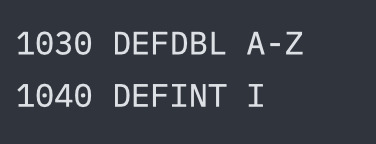
I guess that the second statement just overrides the first.
There is no stack in a BASIC program, so there will be no stack in my language. Instead you just give names to locations.

creates a symbol named age and makes it refer to 0x1F. The pointer operator should be obvious, and the walrus means we're defining a symbol (to be replaced like a macro), not doing a value assignment during the execution of the program. Now we can assign a value.
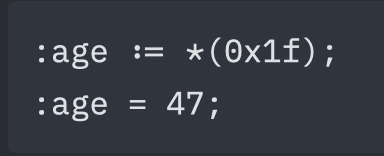
Atoms infer types. age knows it's an int.
You cannot assign a new type to an atom.
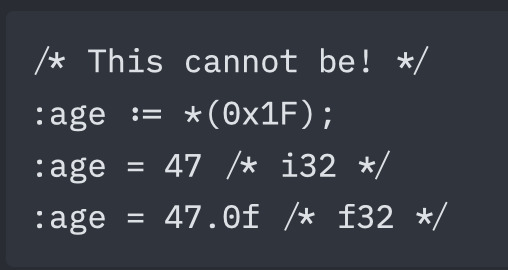
However, you can cast between types by creating two atoms at the same address, typed differently.
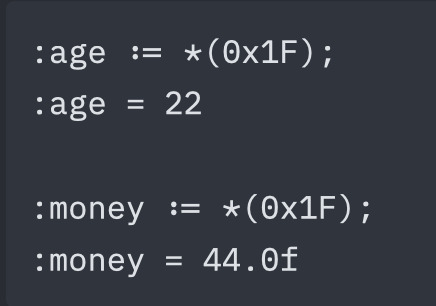
The language does not convert these, it simply interprets the bits as the type demands.
Larger types
Not all types are a single word. Therefore, you can use the range operator .. to refer to a range of addresses.

Note that strings are stored with an extra byte for its length, instead of null-terminating it. Assignment of a string that is too long will result in a compilation error.
Next and Auto
There are also two keywords to make the layout of memory easier. The first is :next which will place the span in the next available contiguous location that is large enough to hold the size required. The second is :auto. For all :auto instances, the compiler will collect all these and attempt to place them in an intelligent free location. :auto prefers to align large structs with 64-word blocks, and fills in smaller blocks near other variables that are used in the same code blocks.
String Allocation
Strings come with a macro to help automatically build out the space required:

This is equivalent to:

That is, a string with capacity 5, a current size of 0, and zeroes (null char) in all spots. This helps avoid memory reuse attacks. ZBASIC is not a secure language, but this is still good practice.
There is also another macro that is similar to a "string literal".

Verbose and annoying! Just like BASIC.
Array Allocation
Likewise, arrays have a similar macro:

Which expands in a similar way as strings, with a capacity word and size word. The difference here is that the type given may change the actual size of the allocation. Giving a type that is larger than a single word will result in a larger array. For instance, f64 takes up two words some systems, so array::empty!(5, f64) will allocate 10 words in that case (5 * 2). Larger structs will likewise take up even more space. Again, all this memory will be zeroed out.
Allocation order
As an overview, this is the order that memory is assigned during compilation:
Manual Locations -> Next -> Auto
Manual locations are disqualified from eligibility for the Next and Auto phases, so a manual location will never accidentally reference any data allocated through :next or :auto.
Here is an example:
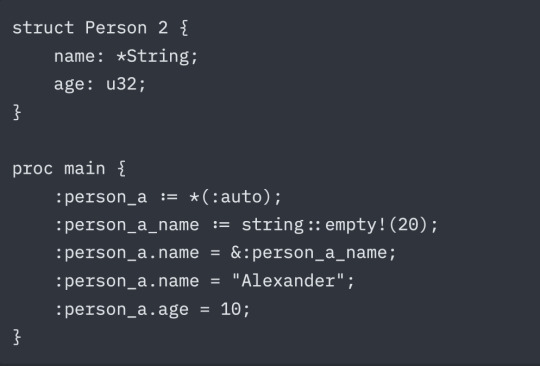
This produces the initial layout:

Which, after the code is run, results in the memory values:

Note that types are not preserved at runtime. They are displayed in the table as they are for convenience. When you use commands like "print" that operate differently on different types, they will be replaced with one of several instructions that interpret that memory as the type it was at compile-time.
Truly awful, isn't it?
3 notes
·
View notes
Text
When whipping up Railgun in two weeks' time for a game jam, I aimed to make the entire experience look and feel as N64-esque as I could muster in that short span. But the whole game was constructed in Godot, a modern engine, and targeted for PC. I just tried to look the part. Here is the same bedroom scene running on an actual Nintendo 64:
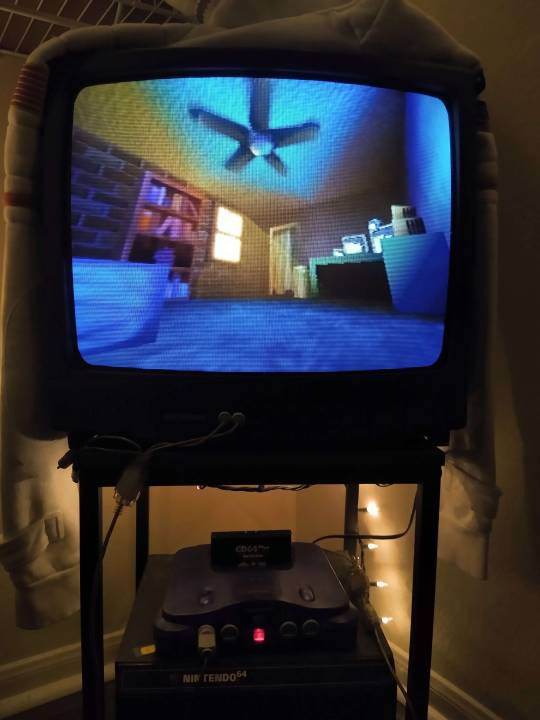
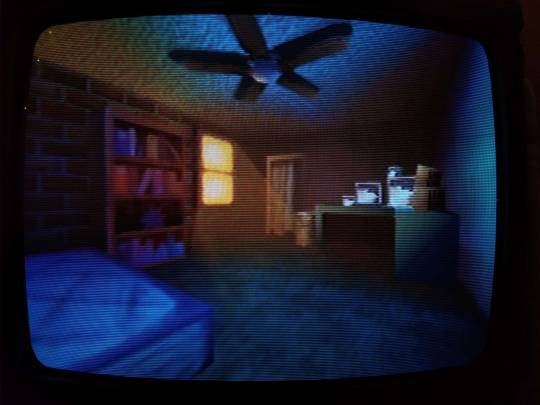
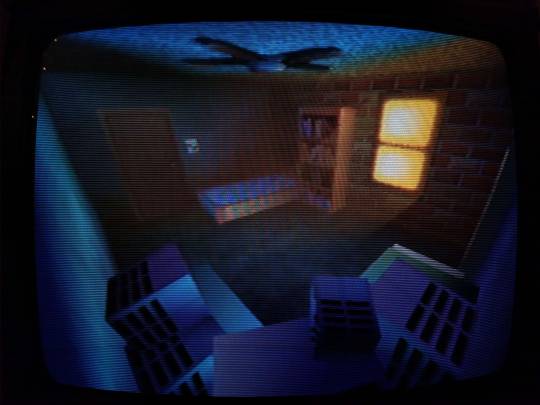
I cannot overstate just how fucking amazing this is.
Obviously this is not using Godot anymore, but an open source SDK for the N64 called Libdragon. The 3D support is still very much in active development, and it implements-- get this-- OpenGL 1.1 under the hood. What the heck is this sorcery...
UH OH, YOU'VE BEEN TRAPPED IN THE GEEK ZONE! NO ESCAPE NO ESCAPE NO ESCAPE EHUEHUHEUHEUHEUHUEH While there is a gltf importer for models, I didn't want to put my faith in a kinda buggy importer with an already (in my experience) kinda buggy model format. I wanted more control over how my mesh data is stored in memory, and how it gets drawn. So instead I opted for a more direct solution: converting every vertex of every triangle of every object in the scene by fucking hand.
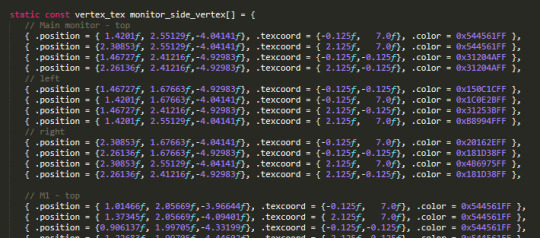
THERE ARE NEARLY NINE HUNDRED LINES OF THIS SHIT. THIS TOOK ME MONTHS. And these are just the vertices. I had to figure out triangle drawing PER VERTEX. You have to construct each triangle counterclockwise in order for the front of the face to be, well, the front. In addition, starting the next tri with the last vertex of the previous tri is the most efficient, so I plotted out so many diagrams to determine how to most efficiently draw each mesh. And god the TEXTURES. When I painted the textures for this scene originally, I went no larger than 64 x 64 pixels for each. The N64 has an infamously minuscule texture cache of 4kb, and while there were some different formats to try and make the most of it, I previously understood this resolution to be the maximum. Guess what? I was wrong! You can go higher. Tall textures, such as the closet and hallway doors, were stored as 32 x 64 in Godot. On the actual N64, however, I chose the CI4 texture format, aka 4-bit color index. I can choose a palette of 16 colors, and in doing so bump it up to 48 x 84.
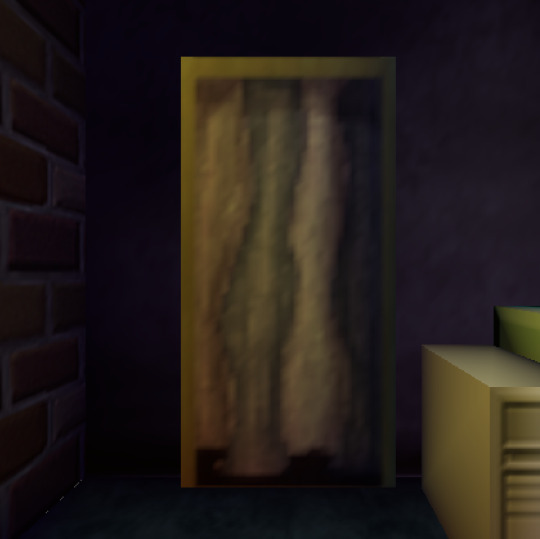
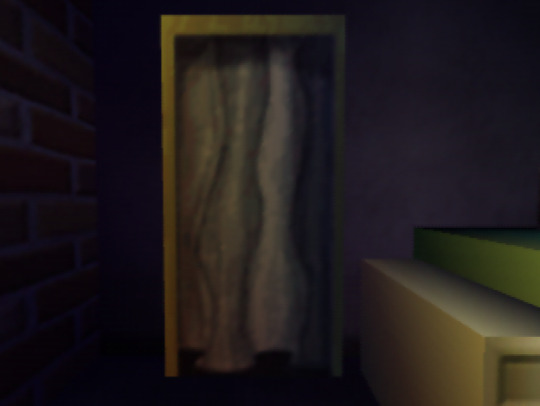
On the left, the original texture in Godot at 32 x 64px. On the right, an updated texture on the N64 at 48 x 84px. Latter screenshot taken in the Ares emulator.
The window, previously the same smaller size, is now a full 64 x 64 CI4 texture mirrored once vertically. Why I didn't think of this previously in Godot I do not know lol
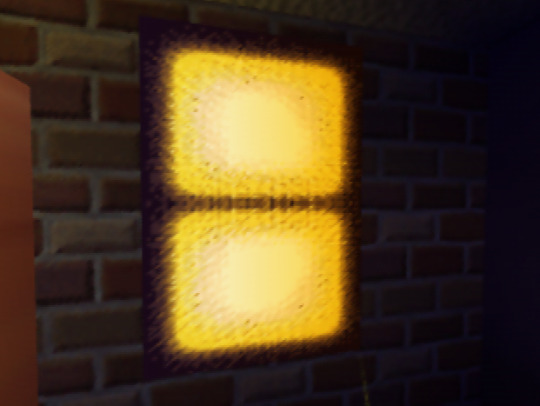
Similarly, the sides of the monitors in the room? A single 32 x 8 CI4 texture. The N64 does a neat thing where you can specify the number of times a texture repeats or mirrors on each axis, and clip it afterwards. So I draw a single vent in the texture, mirror it twice horizontally and 4 times vertically, adjusting the texture coordinates so the vents sit toward the back of the monitor.


The bookshelf actually had to be split up into two textures for the top and bottom halves. Due to the colorful array of books on display, a 16 color palette wasn't enough to show it all cleanly. So instead these are two CI8 textures, an 8-bit color index so 256 colors per half!! At a slightly bumped up resolution of 42 x 42. You can now kind of sort of tell what the mysterious object on the 2nd shelf is. It's. It is a sea urchin y'all it is in the room of a character that literally goes by Urchin do ddo you get it n-
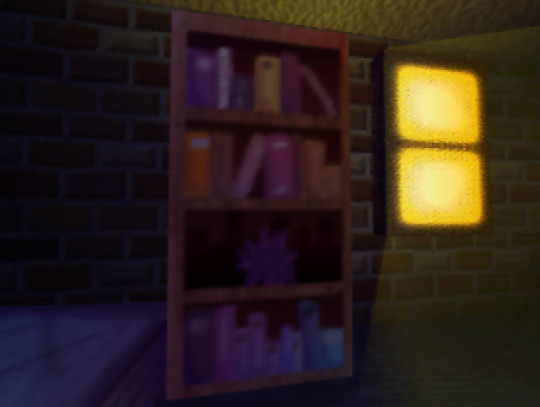
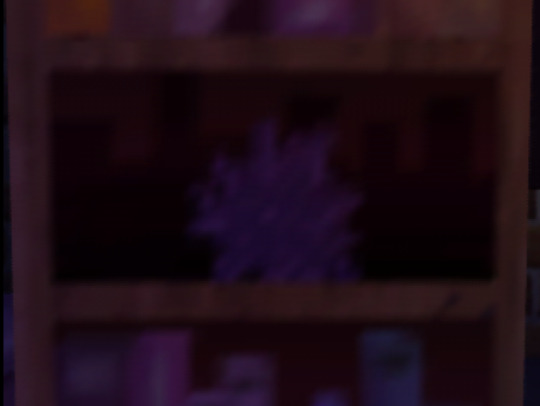
also hey do u notice anything coo,l about the color of the books on each shelf perhaps they also hjint at things about Urchin as a character teehee :3c I redid the ceiling texture anyways cause the old one was kind of garbage, (simple noise that somehow made the edges obvious when tiled). Not only is it still 64px, but it's now an I4 texture, aka 4-bit intensity. There's no color information here, it's simply a grayscale image that gets blended over the vertex color. So it's half the size in memory now! Similarly the ceiling fan shadow now has a texture on it (it was previously just a black polygon). The format is IA4, or 4-bit intensity alpha. 3 bits of intensity (b/w), 1 bit of alpha (transparency). It's super subtle but it now has some pleasing vertex colors that compliment the lighting in the room!

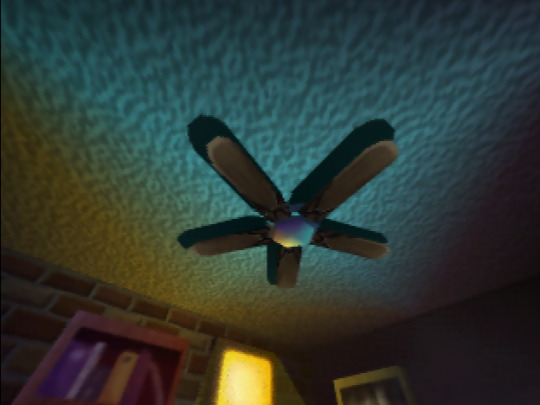
Left, Godot. Right, N64. All of the texture resolutions either stayed the same, or got BIGGER thanks to the different texture formats the N64 provides. Simply put:
THE SCENE LOOKS BETTER ON THE ACTUAL N64.
ALSO IT RUNS AT 60FPS. MOSTLY*. *It depends on the camera angle, as tried to order draw calls of everything in the scene to render as efficiently as I could for most common viewing angles. Even then there are STILL improvements I know I can make, particularly with disabling the Z-buffer for some parts of the room. And I still want to add more to the scene: ambient sounds, and if I can manage it, the particles of dust that swirl around the room. Optimization is wild, y'all. But more strikingly... fulfilling a childhood dream of making something that actually renders and works on the first video game console I ever played? Holy shit. Seeing this thing I made on this nearly thirty-year-old console, on this fuzzy CRT, is such a fucking trip. I will never tire of it.
46 notes
·
View notes
Text
I was watching SCP videos, along with Pokespe stuff, and an idea came to me
SCP- 6517
Gotta Catch ‘Em All Part 2
6517 is an unassigned number as of the time of this post
Object Class: Euclid
What if the effects of SCP-5254 didn’t just apply to the Pokémon creatures? What if it was extended to the human characters featured in various Pokemon-related media as well?
SCP- 6517 refers to a series of cosplay costumes produced and sold from a particular website.
This website is called PokeTrainer Depot, which features a wide array of character costumes specifically themed to media released by the Pokemon Company and its affiliates.
Analysis of these costumes by themselves, even as separate pieces, reveals nothing inherently anomalous about them. They appear to be constructed of normal clothing materials such as cotton, denim and some plastic. Even chemical analysis revealed nothing out of the ordinary.
However, tags with the acronym AWCY? have been found inside the clothing articles, suggesting a connection to the avant garde art association Are We Cool Yet?.
Access to the website has been restricted to the public and can now only be accessed by the SCP Foundation given the necessary clearance.
Efforts are ongoing to keep the website from popping back up, as Ser_Viper seems determined to sell them all.
No pop-up or brick and mortar locations have been reported to date.
There is also no factory name on the labels found within the costumes. Just the logo of the website and washing instructions alongside the AWCY? logo.
Navigation of the site is relatively simple, with the costumes divided into sections based off of which ‘Generation’ they originated in.
For example, Generation 1 refers to the characters introduced in the 1996 releases of Pokemon Red, Pokemon Blue, and Pokemon Green as well as Pokemon Yellow in 1998. It also includes the remakes, namely Pokemon FireRed and Pokemon LeafGreen released in 2004.
SCP- 6517 was first discovered in 2022, post pandemic when a female cosplayer decided to go as one of her favorite Pokemon characters to a local convention, but didn’t have the time, talent or resources to make the costume herself.
So, she ordered it online.
After browsing several sites, ranging from Party City to Spirit Halloween, she found PokeTrainer Depot. It seemed to be of the quality she wanted and for a decent price (converted from yen to USD).
The costume was based on Rosa, the female Player Character from Pokemon Black and White 2.
She received the costume in the mail after about two weeks, and she immediately tried it on for size.
It fit her fairly well, though the wig was a bit cumbersome. She took it off after twenty minutes. She figured that was long enough to break it in.
A few weeks later, she attended the convention with a few friends, who were also going as Pokémon characters, and had a fun time.
They attended a few panels and ogled over other people’s art and crafts for sale.
After the cosplayer had worn the Rosa costume for over three hours, she started to feel an itchiness in her eyes that refused to go away.
She regretfully had to leave the convention due to the prolonged discomfort.
Once at home, the cosplayer removed her Rosa costume and slipped into something more comfortable. She took some painkillers and laid on the couch in her living room, eyes closed and waiting for the pain to stop.
Once it subsided, she felt the call of nature. As she finished up, she looked at herself in the mirror and gasped.
She noticed that her eyes had changed color to match that of the character.
She was confused and a little bit scared. She didn’t wear contacts, so how did this happen?
Freaked out, she contacted her doctor about the sudden eye color change.
She made an appointment for one week from then.
In that time, the young woman still had to go to work, but she noticed other changes as well.
Her hair grew longer and started to change color, though she was already a brunette so the color change was subtle.
Her skin tone changed as well, though again it was subtle as she was already caucasian. She felt a stinging sensation along her skin as it changed, though, preventing her from sleeping and thus arriving to work the next morning sleep deprived.
When the day of her doctor’s appointment came, she still looked like herself, save for the eyes, hair and skin tone.
She decided to wear her suddenly-longer-hair in a ponytail.
The doctor looked her over, tested her blood pressure and all the usual checkup procedures. When it came to blood and urine tests, the results were… unusual.
So unusual in fact, that her physician contacted their peers, which eventually reached the ears of the SCP Foundation.
The cosplayer lived alone in a rented apartment while working retail at a large name brand store. Her coworkers noticed the changes in her eyes and hair and complimented the cosplayer on it.
Though the pins and needles-like pain she felt in her body made her worried.
Over the course of the next two weeks, the cosplayer experienced further physical changes, including height and a visible de-aging. She looked like she was twelve again.
She also started blacking out without explanation, appearing someplace else some time later.
It was around then that the SCP Foundation went to the cosplayer’s home to investigate.
She let them in with no fuss and complied with answering their questions.
The entire conversation was recorded for future analysis.
She admitted she had to call in to work the past few days because she felt there was something seriously wrong with her.
The blackouts frightened her, and the pain and discomfort she felt in her body didn’t help. She knew it wasn’t time for her menstrual cycle yet.
It was like she was an alien in her own body.
As she was trying to explain her situation to the SCP Agent, she seemingly blacked out again, going silent and still for a moment. But she didn’t pass out.
When she looked back up, she wasn’t as shaken or anxiety-ridden as she was before.
It was as if she was experiencing a personality disorder, and another personality had taken over.
The Agent continued with their questioning, asking the new entity to identify itself.
It identifying itself as Rosa, a saddened look on her face.
She also complied to answering questions, while asking several of her own.
She admitted to being very confused as to where she was most of the time, and that she felt guilty about inconveniencing her host once she realized what was happening.
‘Inconveniencing’ was an understatement.
She knew she was no longer in Unova. She was in someplace called New York, where Pokémon existed only in fiction. As did she.
But Rosa wasn’t worried by this. Quite the contrary.
Rosa told the Agent that the last thing she remembered before waking up in the cosplayer’s apartment was darkness.
Her memories in fragments, recounting events extremely similar to that of Pokémon Black and White 2 from her perspective, with realistic details that the game and its adaptations never mentioned.
The Agent was able to help clarify the situation for the displaced Pokémon trainer, and asked her if there was any way to reverse the process.
Rosa shook her head sadly.
There wasn’t one she was aware of, as it wasn’t meant to be reversible.
Before the darkness, she remembered the end of her adventure.
While she was in the darkness, she heard a voice telling her that her story wasn’t finished yet. That she would be given a chance at a new life in another world.
Soon after that, Rosa switched out with the cosplayer, who panicked upon waking.
The Agent informed her of what Rosa had explained, as she had not been conscious for the duration.
The cosplayer directed him to the website she ordered the costume from.
The cosplayer was taken to Site 19 for containment and further questioning.
All the while, the Foundation contacted their Site in Japan, wanting to know if the Nintendo Company knew anything about the PokeTrainer Depot website.
It turned out they didn’t, and any instances of SCP- 6517 were already being kept secret from the mega million dollar company by an unknown third party.
Understandably.
If they found out there were cosplay costumes that successfully turned humans into their characters, albeit not the Pokemon themselves, it would be like SCP-5254 all over again.
After some digging into the website, analysts found an address attached to the sender of the anomalous costumes.
Members of special task force MTF Epsilon-11 ("Nine-Tailed Fox"), the same task force responsible for neutralizing SCP-5254 instances that manifest in public spaces, were dispatched to the address to investigate and secure any instances of suspected SCP-5254 and/or SCP- 6517 that may be on the premises.
The location was a house in the Kansai region, surrounded by fields and sparse trees. The house was of traditional Japanese design with a second floor and some modern amenities.
When the MTFs arrived, one operative observed that there was someone waiting for them outside, sitting on the front porch.
They appeared to be a Japanese woman with long dark hair kept in a high ponytail wearing a simple loose shirt and long skirt. She appeared to be in her late 20s.
When the MTFs approached, she showed no resistance or hostility. She even showed them inside upon being asked.
She had seen the trucks coming and knew what it meant.
They soon found a group of children and teenagers, ranging in age from 10 to 14 years, huddled in the living room.
The woman urged the children not to resist and to go with the MTFs willingly.
She asked if where they were going was safe. One agent responded that yes, they would be kept safe and secure until they could better determine what to do with all the transformed persons.
But that wasn’t up to the MTF.
The woman was identified as Keiko Nakamura, daughter of the mysterious Ser_Viper connected to SCP- 5254
She informed them that her father’s real name was Eiji Nakamura, but suspected that he would’ve changed his name to stay hidden by now.
That much information was better than nothing.
Keiko requested to come along with the SCP- 6517 instances so they may feel less afraid.
The request was approved.
Keiko was immediately brought to an interview with a SCP researcher assigned to SCP- 6517, Dr. Ruka Onata.
Keiko confessed that she knew this day would come, and had made rudimentary plans for such an occasion.
She confessed that she was the one who suggested to her father about bringing the human characters to life too.
It gave the man the idea to create the costumes sold on the PokeTrainer Depot website, working with AWCY? to produce them. He continued to create and add to the collection with every new Generation and characters created by the Pokemon Company.
She had no idea where he was doing it from, as they’d cut ties after she found out about his involvement with SCP-5254
It had been about five years prior when Keiko encountered the first instance of SCP- 6517.
She had been driving home from work in the city, and had just parked her car in the driveway when she saw someone on the porch.
It had been raining, and the rain obscured the person’s shape, though they didn’t seem to be moving.
Upon closer inspection, Keiko saw it was a girl around 9-10 years old, who had fallen asleep on her porch, seemingly waiting for her return.
Concerned, she picked the girl up and brought her inside without thinking twice. It wasn’t until after she’d laid the girl down on some tatami mats that she noticed the blonde coloration of her hair and odd clothing.
The next thing she noticed was that she was running a fever.
Keiko nursed the mysterious girl back to health, during which time she learned her name was Yellow and where she came from.
She confessed that her host’s name was Himawari, fittingly enough. It meant sunflower in Japanese.
When Keiko looked into the website herself, she was angry at Ser_Viper that he’d put her address on the site, seemingly using her as his scapegoat.
Attempts to change it were futile, and she couldn’t move away due to financial restrictions.
Without much of a choice, Keiko let Yellow stay in her house but she had to earn her keep and so the Pokemon Special character became her adopted daughter and housekeeper.
Over the next five years, characters from Generations 1 to 4 had shown up at her house, following the same logic as Yellow had only to be disappointed.
Keiko let them all stay with her… until the SCP Foundation arrived.
She found that any Pokémon character costumes after Gen 4 were not available in Japan, and the same could be said in other countries.
Gens 5 and 7 were only available in America, Gen 6 was only available in France, Gen 8 was only available in the UK and Gen 9 was only available in Spain.
Notices were given out to SCP Sites in these countries in case instances of SCP- 6517 were ever reported.
As previously mentioned, the MTF squad had recovered several children from Keiko’s home, all possessing physical and personality traits matching that of various Player and Rival characters from before Generation 5.
These include:
Kiiro (SCP- 6517-A), also known as Yellow
Age: 15
Akai (SCP- 6517-B), also known as Red
Age: 20
Midori (SCP- 6517-C), also known as Blue Oak or Green
Age: 16
Aoi (SCP- 6517-D), also known as Green, Leaf or Blue
Age: 20
Hibiki (SCP- 6517-E), also known as Ethan, Kin or Gold
Age: 17
Gin (SCP- 6517-F), also known as Silver
Age: 17
Kris (SCP- 6517-G), she is not known by other names, though she sometimes answers to Kotone or Lyra.
Age: 17
Yuuki (SCP- 6517-H), also known as Brendan or Ruby
Age: 15
Haruka Birch (SCP- 6517-I), also known as May or Sapphire
Age: 15
Wally (SCP- 6517-J), also known as Mitsuru.
Age: 15
Hikari Berlitz (SCP- 6517-K), also known as Dawn, Shirogane or Platinum
Age: 12
Kouki (SCP- 6517- L) also known as Lucas, Dia or Diamond
Age: 12
Jun (SCP- 6517-M), also known as Barry, Shinju or Pearl
Age: 12
While under initial containment in Research Site-79 in Tokushima, the victims of SCP- 6517 were kept in separate humanoid containment cells decorated to resemble relatively normal bedrooms.
They were later transferred to Site 19 in the USA for their own safety and because they had the additional housing necessary.
Luckily, the subjects were discovered to be multilingual, adapting to the many languages the Pokémon games are translated into.
Through testing, as with instances of SCP-5254, the effects of SCP- 6517 were irreversible, try as the researchers might.
Several trials were conducted to see if the subjects of SCP- 6517 could recall the memories of their hosts.
Some of these trials were successful, but it left the subjects with symptoms of a looming existential crisis.
To mitigate this, an on-site counselor was assigned to SCP- 6517 to help the subjects through this difficult time.
Other attempts to reverse the transformation with the twelve previous instances were proven ineffective, whether it be through hypnosis, wearing the Host’s old clothes or surrounding them with things that would hopefully trigger something from the Host’s memories.
The instances did divulge that while they could access some of their Host’s memories, their souls were gone.
For all intents and purposes, the original hosts were dead.
The Department of Misinformation made sure that the hosts’ deaths were made official despite having no bodies to show for it, the disappearances covered up and their families notified.
To test the effects of SCP- 6517 for themselves, Site 79 researchers ordered a cosplay of Lance, also known as Wataru in Japan, from PokeTrainer Depot.
Using Rosa’s testimony as a guideline, the researchers made the D Class keep the Lance costume on for three hours. When he began to complain of itchiness in his eyes, he was instructed to remove the costume.
The D Class was kept under surveillance for the next two weeks, during which time several notable physical changes occurred.
The D Class was originally a middle aged man with balding hair, a beard, and a portly body.
His eyes and hair changed color and shape. He also got taller, thinner with more angular features, and de-aged until he appeared to be in his late 20s.
He looked like Lance wearing the orange jumpsuit of a D Class.
They extracted samples of the D Class’ DNA every day, which allowed them to track how fast the effects of SCP- 6517 took to completely override the host’s DNA.
They also kept track of his brain waves, for when the other personality manifested.
It was after those two weeks that the D Class’ brain waves were replaced by another’s, though briefly.
Through interviews with the other personality, identifying itself as Lance, the SCP researchers learned that these instances borrowed several traits from the host in order to fill in gaps in their own personalities.
After the third week, the D-Class was gone, fully replaced by a walking and living version of a human Pokemon character.
The Cosplayer who became Rosa was given the designation of SCP- 6517-N.
After the transfer to Site 19, several other D-Class personnel were used to test the effects of SCP- 6517.
Lance was given the designation of SCP- 6517-O.
Three other characters were brought to life in this process, including N (aka Natural Harmonia Gropius), Cynthia (aka Shirona), and Hilda.
They are 20, 27 and 16 years old respectively
They were given the designations of SCP- 6517-P, Q and R.
Given that there were so many of them, the 0-5 Council allowed them to be moved to a separate location where they could be monitored but otherwise allowed to lead relatively normal lives.
The location was a campground located in Nevada.
The campground encompasses five acres of land, bordered by a concrete wall that only SCP personnel have clearance to enter and exit at any time.
The instances of SCP- 6517 have been given access to one acre of fruit trees and garden vegetables they tend to themselves.
The other four are woodlands that surround the campground.
Other food items and necessities are provided by the Nintendo Company as compensation for their involvement in the SCP-5254 fiasco that led to SCP- 6517.
The boys and girls sleep in separate cabins, as do the adults.
Personnel are assigned to act as Camp Directors, helping the instances adapt to how our world works and the animal species.
It is noted that they all own plushie versions of their individual Pokémon teams.
Addendum:
Having found the essay Eiji Nakamura had to prepare for the AWCY? Exhibition in 2014, SCP agents found exactly what they were looking for in terms of how SCP- 6517, and by extension SCP-5254 really worked.
The costumes were manufactured using a thread coated in an anomalous substance, one that once soaked through became indistinguishable from the thread itself. If used to stitch together clothing, the effects of the substance would spread to it as well.
The effect was listed as ‘transformation into the subject of the costume itself, believing themselves to be a certain character over a period of time.’
Other ways SCPs can bring Pokemon to life:
SCP-387 Living Lego
Lego Pokemon exist now
SCP- 507 Reluctant Dimension Hopper
If he somehow landed in the world of Pokemon and brought some back with him
9 notes
·
View notes
Text
advent of code 2023 day 1
so for the record i'm being pretty casual about this, i have stuff going on this month + my health is wonky as usual so i may not actually be doing this everyday, might do puzzles late, etc
anyway! i'm still a bit of a novice i think, but i decided i would try out this advent of code thing, seemed fun. i'm using html/javascript since that's what i have any experience in right now.
my solutions below the cut so you aren't spoiled if you want to do it yourself!
i decided to keep my part 1 and part 2 solutions separated, they're on the same document. i have some really basic HTML that looks like this:
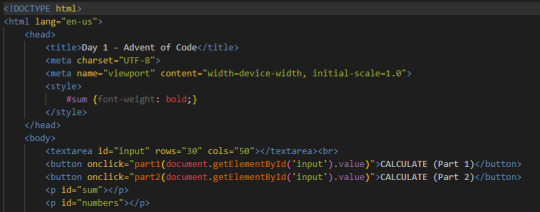

and this was my solution for part 1 before words got involved:

for the record i have taught myself basic RegEx multiple times, and every time i forget nearly everything, so most of my time spent on this solution was refreshing myself on a little bit of RegEx. i think this is pretty straightforward - split the input by line, then loop through each line and remove anything that isn't a number, then take the first and last digit in each of the remaining strings, add them all together for the result.
the solution for part 2 on the other hand:
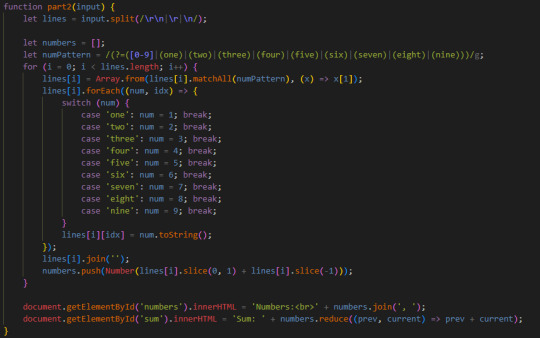
i actually found this somewhat frustrating because the problem itself didn't clearly explain whether something like "eightwothree" in the provided example should be "8 2 3" or "8 3"... my original solution disregarded overlapping words like that. this caused issues because if you had something like... i don't know, threeeightwo, my program would make the resulting two digit number 38 instead of 32, resulting in a wrong sum when adding all of them together.
once i realized the issue i was a bit stumped on how to deal with this and get the overlapping words to be included. i knew that i could manually loop through each position in the string, looking for any of the nine digits in either their letter or numeric form, and when it finds a result, push it to an array of results or whatever, but i really didn't want to do that because it would be unnecessarily bulky in my opinion. and i wanted to keep experimenting with RegEx instead. so after some googling i landed on amending the numPattern and changing
lines[i] = lines[i].match(numPattern);
to
lines[i] = Array.from(lines[i].matchAll(numPattern), (x) => x[1]);
and while it works great, i admittedly don't fully understand it. like, conceptually i get its intention and the end result it spits out, but i wish i understood what was happening under the hood with .matchAll() better. i tried to wrap my brain around it, but i'm too hungry and too sick feeling to properly teach myself right now, so i've decided to drop it and if it's still itching at me later, i'll come back when i feel better to understand it.
anyway, after that, still pretty straightforward - once it's taken out all of the numbers in both numeric and written format, it loops through the results and converts the words to digits, then joins all the digits together, then does the same thing as before with slicing off the first and last digit to make two digit numbers and adding them all together at the end with .reduce().
15 notes
·
View notes
Note
your colour seperating program, I made something basically identical a few years ago in Python, would love to hear an in depth everything about it, especially how you made the spinning gif
Sorry for the delay I've been kinda busy. I also had various reasons I didn't want to share my code, but I've thought about a better/different way so here it goes (but for the time being I'm as far away from my computer as I possibly could)
I used processing, which is, as far as I remember, based on java but focused on visual media
Starting with the gif part, processing has the save() and saveFrame() methods that save the image displayed, and it also has the "movie maker" that allows you to make GIFs (and others but I don't remember)
I don't know about other languages but processing runs setup() when it starts and draw() every frame
In setup() I load an image as a PImage (processing's image data type like an array or string) and access it's pixel list. Using that I fill a 256x256x256 int array where every color corresponds to a place in the array. This 3d int array is filled with the amount of times each color appears
Lastly I use a log function to convert those numbers into the dot size
During draw() I run through this array and use the point() method to draw every dot (I can define a dot's color using stroke() and it's size using stroke weight() )
There are some optimisations I don't have the patience to explain at the moment
Processing has various render modes. I've made 3d images using the 2d render but I didn't want to repeat the feat (pov: you make 3d in 2d and then your teacher explains the existence of 3d to you). It also has the translate() that moves the origin and rotate(), rotateX() rotateY() and rotateZ() that allows you to rotate the image
I don't know how much you know about processing so sorry if you don't understand or if I'm explaining things you already know
8 notes
·
View notes
Text
Why, What, and How; tuples in rust
When I first learned rust tuples were a tad funky, they were like arrays, but not index-able at runtime, I had never really touched something like that before (to my understanding), so I figure I should share my way to get my head around them.
Why
tuples serve simple role, compound multiple types into one, which is great for returning multiple values, if I want to return a string, and some sort of flag to say what that string could be representing, I can just return (String, T), then the caller can use T to determine what to do instead of mucking around with complicated string parsing.
perhaps I need two or more values of possibly different types to represent what I'm representing, for example a simple Linked list node may want to be an optional pointer to the next node, and it's value; Like (T, Option<Box<(T, Option<Box... wait a minute this is recursive, It needs a name to be written out like this so you should use a struct not a tuple! but what's a struct?
What
something that blew my mind is the ability to know what a struct is, it's an named tuple, if you give a tuple a name, and maybe some trait impls or methods, you've made a struct, simple as.
this is why the syntax to get a field and to get a tuple element is so similar, tuples use numbers instead of names, but their the same concept.
but that doesn't actually explain what a struct or a tuple is, it's pointing to the other and saying their the same.
How
a tuple is a chunk of contiguous memory, with a known (to the compiler) layout, it's like if an array could have multiple types, it holds all it's elements together in a sequence and you can cut out all but the value you want since you know where it is already. the reason you can't index them at runtime is that array indexing is done by moving X bytes over in memory in the array to reach the next element, which only works when you know what size something is going to be and what type it is.
A fun edge case, unit, or ()
unit is a seemingly useless type, why have a compound of nothing? it's purpose is definitely a valid one, having a single value type is a great way to round off the Rust type system, it takes no space, it's the representation of nothing, but why an empty tuple instead of some special primitive? I'd bet it's cause consistency, () has all the properties you would expect an empty tuple to have, an already existent syntax meaning no new keywords or names need be learned to use it, and is straightforward representation of nothing.
Tuple Tips!
if you're tuple is made of less than 13 elements that all implement Default, the tuple does as well, it's default value is all the default values of its elements.
if your using two equal length arrays and want to pair them together, consider instead make an array of two element tuples; think [(T1, T2)] instead of ([T1], [T2]), great for iterating over pairs of statically known values.
if your struct is just some behavior over a simple enough set of values (like an Rgb type just being (u8, u8, u8)), consider implementing Into and From for those tuples so you can easily convert between them
3 notes
·
View notes
Text
More on Mid-Sized Cities

A few weeks ago I posted a very lengthy rant on the problems of urban Progressivism. One thing I mention is the considerable success of small and mid-sized cities relative to large cities. Recently I had come upon a report from the Brookings Institution highlighting my hometown of Winston-Salem and their success in converting downtown office space into other types of uses. I think Winston-Salem's success with office to residential conversions is indicative of a number of factors that make development in a mid-sized city more favorable versus a large metropolis:
A willingness to play ball: Mid-sized cities will lend considerable time to a developer willing to take a chance on a novel development opportunity and frequently will modify city regulations in order to make way for a new and emerging real estate market.
Suitable financing opportunities: A mid-sized city has various gap financing mechanisms it can utilize to bring a development across the finish line. Such financing arrangements may be necessary if the project has a lot of moving parts or has never been attempted within the region. Major American cities frequently exhibit a kind of go big or go home mentality. A signature urban project can go into the billions, which means big city administrators are more content to rest on their laurels and not innovate their development practices.
At the other end of the extreme, a small town will have little to offer in the way of money unless its through a major benefactor (a college or major company). A mid-sized city offers greater economies of scale than a small town and, more importantly, financing options.
Well-Trained Staff with the ability to Navigate Through Institutions: The Brookings report was highly complimentary of Winston-Salem's planning staff and while that may be true I doubt they have the skill and acumen of a large planning staff like New York or Chicago. What they do have though is the ability connect to key movers and shakers in the city. A city like Winston-Salem (population around 250,000) has a decent array of players. Large enough to provide flexibility, but no so large that it can't be easily navigated by an astute observer.
There's the old guard, local citizens who made bank during the days of RJR/Nabisco and Hanes. Next you have the major employers in Winston right now (Wake Forest, the two major hospital systems). Any development, no matter how novel, can move forward if one can bring these players to the table. Then you have up and comers, small entrepreneurs and nonprofits with a quirky idea they wish to conceive. In Winston-Salem, institutions like A/perture Cinema and the Sawtooth Center add a unique character downtown and help expand the slate of activities the city has to offer. If you understand the terrain of the neighborhood and who would be the appropriate ask for a certain type of development, your venture stands a good chance of succeeding.
You can be the Big Cheese!: Finally, a developer or brand can achieve notoriety and recognition with far greater ease than in a big city. A number of years ago, the Reynolds Building was converted into a Kimpton Cardinal Hotel. Built in 1929, the Reynolds Building was, for many decades, the tallest building in the state and was designed by the same architecture firm that worked on the Empire State Building. Its Art Deco facade is often lit different colors for special holidays and city events. Its the type of property that brings instant name recognition and notoriety to whoever occupies it.
Signature properties in large cities are coveted by powerful institutions and can be difficult to get a proper foothold on. For example, NBC Studios have been in 30 Rockefeller Plaza in New York City longer than television! Building a glitzy, new property is a way of drawing attention, especially in a high growth market, but the window for success can be quite brief. Of course that is assuming you can successfully navigate the high barriers to entry and can curry favor with the right set of committees. Its far easier to build a portfolio of signature properties in mid-sized markets and, if you so desire, use that real estate portfolio as leverage to break into a major city. Who knows, if the city you work in is on the cusp of hitting the big leagues, then maybe your firm can achieve national notoriety as well!
0 notes
Text
Major Study
Production Post #8
Concept Design: Player's Base
Moving into the realm of environments, I wanted to revisit some aspects of world-building, not to conceptualise for the deadline in August, but there after. It's important that I consider the wider world when designing the player's base as it can inform building materials and what would be a privately owned amenity versus one shared by the community.
The Purpose of the Player's Base
The purpose of this game is to capture the sense of adventure from exploring a new, mostly uninhabited part of the earth (similar to the wild west).
The settlements located in the game must have a sense of purpose to feel lived in and legitimate.
Taking inspiration from the purposes of Wild West towns that all had clear purposes visible in their designs: These included towns focused on mining, farming, railroad and trading, military forts, whaling stations, monasteries etc.
Ideas for solarpunk settlements:
phenomena research stations.
Towns based on a Renewable energy: giant hydro, sun/borealis solar farms.
Inuit-owned cultural centers (showing the difference between this ‘colonisation’ and more invasive wild west colonisation.
Inuit values to include in town design: sharing resources & knowledge, sustainable living, respect for nature, wisdom of elders and teaching through song, stories and legends, family, arts and crafts, music and dance.
Trade and crafting-based.
Mining.
Eco Tourism.
Farming.
Town to Focus on and Design Phenomena Research Stations
Central focal point - strange original design of a large antenna/sail/dish/array.
Surrounding laboratories.
Power - solar array on outskirt.
Local food growing labs - hydroponic farms.
Cultural centre: Traditional garden (inuit culture), small school / library / gallery, community centerpoint. (circular pattern of base).
Living quarters.
Tavern, Arcade.
NPC Architecture
Other buildings in universe not to design as much but may appear in concept art:
Ruined non-solarpunk military facilities from world governments.
Old whaling stations converted to a faction.
Native/Inuit camps / towns / religious sites.
Structures / geological formations made by Northern lights creatures.
I grouped the following research into catagories based on the above points of architecture to consider:



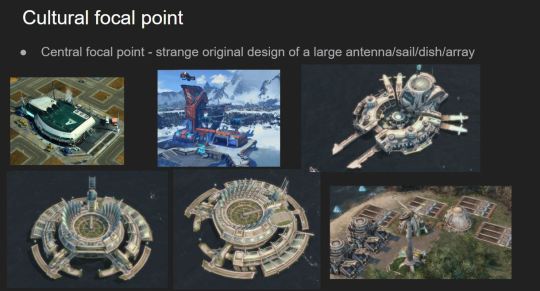





Most of these research images are from Anno 2070 as it could be considered the nearest solarpunk game with it's earth-focused futuristic designs.
Using these designs and my past research for player base, I created this thumbnail painting exploring a small rigid tent-like structure on a raised platform above the player's farmland. I created some height with a landing pad for the hovering craft and solar panels designed to double up as shelter.
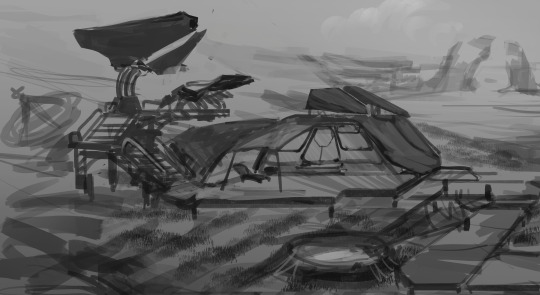
This was my first iteration of the base design, but I wanted to explore alternative housing options for the base. During my peer review, number 4 was the most popular choice due to it's circular design. This is a great choice to consider as it better matches the community aspects of Inuit culture as well as hearkening back to the circular designs of an igloo.
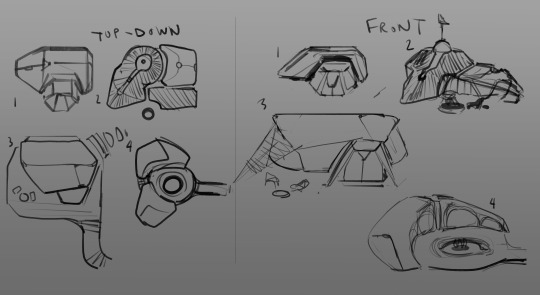
I'm going to try some more versions using a circular design, however, it's important to remember that the materials and building parts will have a re-used and recycled aspect to them and should not have too many pre-fabricated curvaceous structures or components. What I mean by this is that the buildings will be made of many parts and not a singular structure.
References:
Related Designs & Blue Byte (2011). Anno 2070. Ubisoft.
1 note
·
View note
Text
Russian tech expert named in Trump report says US intelligence never contacted him
A Russian venture capitalist and tech expert whose name and company are mentioned in the now-notorious document alleging connections between the Donald Trump campaign and Russian hackers says no intelligence officers have ever contacted him about the accusations, which he says are false. A report compiled by a former Western intelligence official as opposition research against Trump was made public Tuesday when BuzzFeed posted its 35 pages. The document included unsubstantiated claims of collusion between the Trump campaign team and the Kremlin.
It also alleged that global tech firm XBT Holding, with operations in Dallas, was instrumental in the hack of leaked Democratic Party emails that embarrassed Hillary Clinton and fellow Democrats. XBT, owner of Dallas-based enterprise-hosting company Webzilla, is run by a successful Russian tech startup expert, Aleksej Gubarev. In a phone interview from Cyprus, where he said he’d lived since 2002, Gubarev said he was surprised to see his name in the report. “I don’t know why I was there,” Gubarev said, adding that perhaps a competitor sought to discredit him. “I still don’t understand the true reason for this report.”
The salacious innuendoes in the periodic reports about Trump’s personal life dominated social media headlines. The mention of Webzilla and Gubarev was among the more specific allegations: that XBT and affiliates “had been using botnets and porn traffic to transmit viruses, plant bugs, steal data and conduct ‘altering operations’ against the Democratic Party leadership.” Gubarev said he operated 75,000 servers across the globe and got real-time information if there had been hacking or illicit activity tied to his businesses. There is no evidence of that, he said, adding that no one has contacted him. “I have a physical office in Dallas. Nobody contacted me,” said Gubarev, adding that 40 percent of his business is handled over the servers it runs in Dallas and the United States accounts for about 27 percent of his global business.
President-elect Trump confirmed Wednesday at a news conference that he had seen the 35-page report, and he blasted it as “fake news” and an “absolute disgrace.’’ McClatchy has reported that Sen. John McCain, R-Ariz., gave the bulk of the report to FBI Director James Comey on Dec. 9. The final pages of the report are dated Dec. 11. McClatchy had the report earlier but couldn’t verify any of its allegations. A federal law enforcement source told McClatchy that the document was being examined as part of a broader FBI inquiry into Russia’s influence on the U.S. election but wouldn’t characterize its credibility. A source familiar with the former Western intelligence expert who compiled the dossier told McClatchy that the ex-spy has extensive experience in tracking activities in the Kremlin.
The report alleges that Gubarev and another hacking expert were recruited under duress by the FSB, the Russian intelligence-agency successor to the KGB. Gubarev said he had not been threatened or blackmailed, nor had his mother, who lives in Russia. Gubarev’s Facebook page shows his wife, Anna Gubareva, and him on the bow rail of a fast-moving luxury yacht. His profile picture shows him behind the wheel of a vintage convertible Citroen. He is the public face of a number of tech companies around the globe. XBT offers an array of tech services, from dedicated hosting of servers and cloud-based storage to developing apps for mobile phones and offering virtual private servers. His company advertises specialized services to software developers, advertisers, gaming companies and electronic-commerce enterprises. It also operates data centers in Russia, Asia, Europe and Dallas.
XBT has been on a buying spree in recent years, accumulating companies in the web-hosting and related fields, including DDoS.com, 1-800-HOSTING, SecureVPN.com, ColocateUSA, Server.lu in Luxembourg, Singapore’s 8 to Infinity, and a site used heavily to host pornography, fozzy.com. It acquired Webzilla about a decade ago, which is a medium-sized web-hosting company. Although Webzilla operates from Texas, it has a “pretty deep Russian client base,” analyst Carl Brooks of 451 Research, a Boston-based consultancy, said in a December interview. “They don’t have a bad reputation, by any means.” He said the same went for XBT Holding: “To the best of my knowledge, XBT is not particularly nefarious.” He estimated annual revenues for XBT between $50 million and $200 million.
Gubarev suspected he might have been named in the report because of comments to Bloomberg’s Russia business columnist Leonid Bershidsky. Bershidsky wrote on Nov. 1 that Gubarev questioned allegations that the Trump organization maintained a server found to have communicated with two servers at Russia’s Alfa Bank, which is also named in the 35 pages of unproven allegations. “Bloomberg asked me my expert opinion,” he said, noting it was the only time he’d ever commented about a U.S. election or U.S. politics. In that column, Gubarev expressed doubt about the conclusions of outside experts who said they had studied the server connections between Alfa Bank and the Trump organization. These experts, Gubarev said, would not have had access to the complete logs of a server they didn’t control.
The Russian-born Cyprus resident may not be a household name in the United States, but he is tied to millions of iPhones belonging to ordinary Americans. Gubarev was a major investor in the app now called Prism. It was one of the most downloaded of 2016 and uses artificial intelligence to turn ordinary cellphone photos into a wide range of painting styles. If law enforcement wants to talk with him, Gubarev said, his door is open. “I’m ready for any investigation. I’m ready to cooperate with everybody, he said.
1 note
·
View note
Text
Digital Marketing Excellence: Artattackk - The Best in Noida
In the ever-expanding landscape of digital marketing, finding the right partner can make all the difference for your business. Noida, a bustling hub of innovation and commerce, boasts several digital marketing companies, but one name stands out prominently – Artattackk.
I. Introduction
A. Definition of Digital Marketing
Digital marketing is the heartbeat of modern businesses, encompassing a spectrum of online strategies to boost brand presence, engage audiences, and drive conversions.
B. The Need for a Top-tier Digital Marketing Partner
As businesses strive for online prominence, the quest for the best digital marketing company becomes imperative. Artattackk emerges as a beacon of excellence, offering a suite of services tailored to propel businesses forward.
II. Artattackk: Setting the Standard
A. Unveiling Artattackk
Nestled in the heart of Noida, Artattackk isn't just a digital marketing agency; it's a powerhouse of creativity, strategy, and innovation.
B. Services Beyond the Ordinary
Artattackk goes beyond the conventional, offering a diverse range of services from SEO and social media marketing to content creation and PPC advertising.
III. What Makes Artattackk the Best?
A. Expertise that Matters
At the core of Artattackk's success is a team of seasoned professionals with a wealth of experience. Their expertise translates into strategies that deliver tangible results.
B. Realizing Client Dreams
Artattackk's success stories aren't just numbers; they are narratives of dreams realized. Client testimonials underscore the agency's commitment to turning visions into reality.
C. Pioneering Innovation
In an industry where adaptability is key, Artattackk stands tall. Constantly innovating, they lead the way with strategies that anticipate and embrace change.
IV. Unpacking Artattackk's Strategies
A. Search Engine Optimization (SEO)
Artattackk's SEO mastery isn't just about keywords; it's a comprehensive approach that ensures websites rank high, driving organic traffic and visibility.
B. Social Media Mastery
Navigating the dynamic world of social media, Artattackk crafts campaigns that resonate. It's not just about likes and shares; it's about building communities and driving engagement.
C. Content that Captivates
In the digital realm, content is king, and Artattackk wears the crown with pride. From blogs to videos, their content captivates and converts.
D. PPC Precision
Artattackk's PPC campaigns aren't just about clicks; they're about precision. Every ad is strategically crafted to maximize ROI and drive conversions.
V. Client-Centric Brilliance
A. Understanding Uniqueness
Artattackk doesn't believe in one-size-fits-all. They invest time in understanding each client's unique needs, tailoring strategies for maximum impact.
B. Customized Solutions
From startups to enterprises, Artattackk's commitment to customization ensures that every client receives a solution aligned with their specific goals.
VI. Success Stories: A Glimpse into Triumph
A. Tangible Impact
Artattackk's success isn't a mystery; it's a track record. Real-world examples showcase the measurable impact they've had on diverse businesses.
B. Metrics that Matter
Beyond success stories, Artattackk's reliance on measurable metrics ensures clients can track and validate the impact of their digital marketing investments.
VII. Navigating Industry Perplexities
A. Agility in Adversity
Digital marketing is a dynamic arena, rife with challenges. Artattackk's agility ensures clients navigate industry perplexities with confidence.
B. Trendsetting Strategies
Staying ahead isn't just a goal; it's a commitment. Artattackk's trendsetting strategies position clients at the forefront of industry trends.
VIII. Bursting with Creativity
A. Dynamic Content Strategies
Artattackk's content isn't just regular; it's dynamic and varied. Bursting with creativity, they keep audiences engaged through an array of formats.
B. Unleashing Engagement
Burstiness isn't just about quantity; it's about quality engagement. Artattackk ensures each piece of content resonates, creating a lasting impact.
IX. Personalization: A Unique Touch
A. Tailored to Individual Tastes
Artattackk's personalization isn't a feature; it's a philosophy. Campaigns are tailored to individual tastes, creating a more meaningful connection.
B. Building Relationships
Beyond campaigns, Artattackk focuses on building lasting relationships. It's not just business; it's about fostering trust and loyalty.
X. Analytics and Data-Driven Success
A. Monitoring for Excellence
Artattackk doesn't leave success to chance. Rigorous monitoring through analytics ensures campaigns are on track, with room for optimization.
B. Continuous Improvement
The power of data isn't just in analysis; it's in action. Artattackk continually optimizes strategies, ensuring they evolve for sustained success.
XI. Specificity and Context: The Winning Formula
A. Niches Matter
Artattackk doesn't cast a wide net; they target specific niches. This specificity ensures campaigns resonate with the right audience for maximum impact.
B. Meaningful Connections
Content isn't just created; it's crafted for meaningful connections. Artattackk ensures every piece adds value, fostering a lasting relationship with the audience.
XII. Engaging Readers: The Art of Conversation
A. Personifying Content
Artattackk's conversational style isn't just a tone; it's a personality. Using personal pronouns, they create content that speaks directly to the audience.
B. Provoking Thought
Rhetorical questions and analogies add depth, provoking thought and engagement. Artattackk's content isn't just consumed; it's experienced.
XIII. Active Voice and Brevity: The Artattackk Style
A. Direct Communication
Artattackk's use of the active voice ensures direct and impactful communication. It's not just about being heard; it's about being understood.
B. Impactful Conciseness
In a world of information overload, Artattackk's content is concise yet impactful. Every word serves a purpose, ensuring the message isn't lost in verbosity.
XIV. Trust through Transparency
A. Open Communication
Transparency isn't just a policy; it's a culture at Artattackk. Open communication ensures clients are informed, confident, and part of the journey.
B. Reporting Integrity
Trust is fortified through honest reporting. Artattackk provides clients with clear, transparent analytics, showcasing both successes and areas for improvement.
XV. Conclusion
In the realm of digital marketing, Artattackk isn't just a company; it's a promise fulfilled. From innovation and personalization to measurable success, they redefine excellence.
0 notes
Text
THE K'SHAN CRUSADE
This is the story from the previous local Crusade league of the ongoing saga of Jorik Andhrimnir, High Skjald of the Wolfspear, as he battled across the isolated planet of K'shan. It comes in the form of the (increasingly lengthy) tales I created when reporting the four results of the game I played, plus my ultimate withdrawal after 10th edition dropped, to the league organiser.
Jorik's saga has carried over to the currently running league, I'll do the same again when that one reaches its conclusion. And then I'll get to work converting up a suitable model for him as I've grown quite attached.
And so we head to a small world, edging humanity’s expansion...
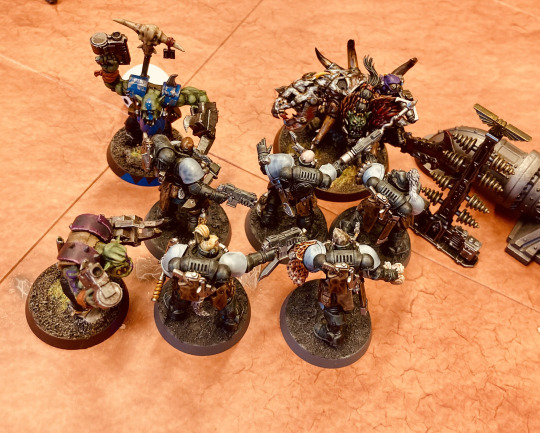
After spotting a Waaagh heading towards a vital part of the defensive lines, the Wolfspear employed their hit-and-run tactics to draw it away to an abandoned manufactorum. The fight is short and bloody - the Warboss wanted a proper scrap and got it, smashing aside the marines.
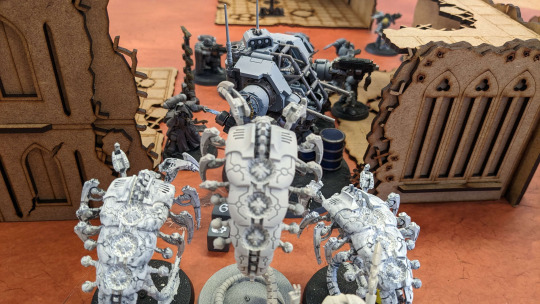
Licking their wounds, the Wolfspear joined up with more of their number at a makeshift base of operations. They barely had chance to draw breath before the Necrons began to phase in. High Skjald Andhrimnir led the counter charge, cutting through the metal ranks with blade and witchfire, but their defences were badly overstretched. When a group of warriors suddenly appeared in their midst, shattering the comms array, the order was given to withdraw.
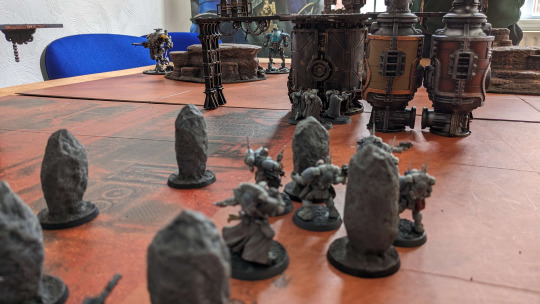
Knowing reinforcements were desperately needed, and with their comms smashed by the Necron assault, High Skjald Andhrimnir knew there was only one course of action left. Tapping into an ancient runic stone circle to boost his powers, he was attempting to make contact with the missing Wolfspear forces deployed on K’Shan when the ground began to shake, and the air filled with a torrent of shells and rockets.
His brothers sold their lives dearly in the face of the Chaos war machines, so as to buy him as much time as possible in order to get the message out. The day was lost, but Andhrimnir was sure he saw the face of the Jarl before his world went black.
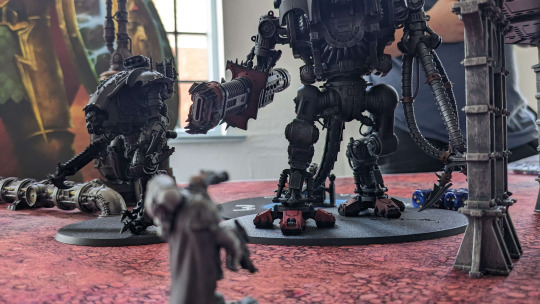
The Wolfspear commanders convened for the first time since they were aboard their strike cruiser. Sharing their gathered intel, it became clear the Imperial defences on K’Shan were in disarray, even before the war horns of the Chaos Knights approaching their position could be heard.
Sick of running, the High Skjald threw himself at the enemy, his blade carving through armour plating before he was smashed into the ground. Sturgard put the wounded War Dog down with an unerring shot, but the day was already lost. Jarl Vaskasson slipped away from the towering monsters with the survivors and walking wounded. Yes, the fight must be taken to the invaders, but the targets needed picking out with the same precision as the First Fang's shooting.

Tracing the last known coordinates of the strike force, the Wolfspear High Jarl arrived in K'shan's orbit and managed to make contact with the troops on the ground. Establishing that the Imperial defences there were in free-fall, combined with the Tyranid threat emerging in the Galactic West, it was determined that the remaining Wolfspear would be of more use deployed elsewhere. As the marines reluctantly boarded the waiting Thunderhawks, Andhrimnir took one last look over his shoulder and swore a blood-oath to atone for his failure.
1 note
·
View note